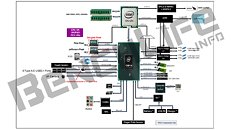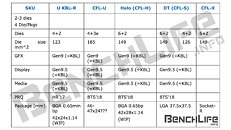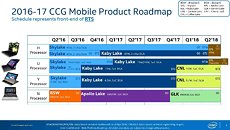Saturday, November 19th 2016

Intel "Coffee Lake" Company's First 6-core Mainstream SKU
Intel's upcoming "Coffee Lake" micro-architecture, or the 9th generation Core processor family by Intel, is scheduled for launch in the second half of 2018. It succeeds the 8th generation "Cannon Lake" family of notebook processors (which likely doesn't see a desktop launch), and the 7th Gen Core "Kaby Lake" socket LGA1151 processors slated for January 2017. While it's not known if mainstream desktop "Coffee Lake" chips will continue to be based on the LGA1151 socket, the possibility is diminishing, looking at a platform layout diagram leaked to the web by Benchlife.info, supported by new connectivity interfaces coming out of the CPU package. The biggest selling-point of "Coffee Lake," is its core-count.
The 9th generation Core "Coffee Lake" family could introduce Intel's first 6-core processor to the mainstream desktop platform. The company's first 6-core client part was launched in its LGA1366 HEDT (high-end desktop) platform with the Core i7 "Gulftown" processor, way back in 2010. An increase in core-count from 4 has eluded the mainstream-desktop lineup. The 6-core "Coffee Lake" silicon will be built on a highly-refined 14 nm node by Intel, with a die-size of 149 mm². Quad-core parts won't be carved out of this silicon by disabling two cores, but rather be built on a smaller 126 mm² die. For reference, the quad-core "Kaby Lake" die is expected to be 123 mm², and the current quad-core "Skylake-D" die measures 122.6 mm².
Source:
BenchLife.info
The 9th generation Core "Coffee Lake" family could introduce Intel's first 6-core processor to the mainstream desktop platform. The company's first 6-core client part was launched in its LGA1366 HEDT (high-end desktop) platform with the Core i7 "Gulftown" processor, way back in 2010. An increase in core-count from 4 has eluded the mainstream-desktop lineup. The 6-core "Coffee Lake" silicon will be built on a highly-refined 14 nm node by Intel, with a die-size of 149 mm². Quad-core parts won't be carved out of this silicon by disabling two cores, but rather be built on a smaller 126 mm² die. For reference, the quad-core "Kaby Lake" die is expected to be 123 mm², and the current quad-core "Skylake-D" die measures 122.6 mm².



46 Comments on Intel "Coffee Lake" Company's First 6-core Mainstream SKU
Edit: Also, 14nm!?! Moore's Law is KIA. Broadwell -> Skylake -> Kaby Lake -> Coffee Lake
I think Intel has replaced R&D with marketing. We already know Kaby Lake is less than 1% clock for clock faster than Skylake so literally the only reason for anyone to upgrade is for marginally faster clockspeeds. I think Intel is going to see a huge market devaluation over the next few years because of the lack of innovation.
Perfect timing for AMD though...
You could examine Intel's most recent 10-Q filings instead of wildly speculating and see Intel continues to spend just over a billion more on R&D than Marketing which also includes general and administrative costs. Intel's most recent net income reported at 11.4 billion and FFS they even bought back their own shares they are so confident. Intel's perceived complacency and stagnation on the desktop processor side has been driven by AMD's incompetence. Responsibility (and greed) demands Intel slow down their product cycle until challenged. We need Zen to hit huge and exceed expectations to give Intel a kick in the pants. As soon as they are challenged they will lay more cards down. Then that will push AMD, then AMD will push Intel, and we are back to great times instead of good times.
files.shareholder.com/downloads/INTC/3258880972x0x912369/A797C312-2EDB-4FF4-930D-BC2B48998008/Earnings_Release_Q3_2016.pdf
The ratio has been unchanged year over year.
Intel's stocks won't slide until after Zen debuts.
Intel buying its own stock I'd call a move to prepare for troubled waters. They have cash now they might not have in a year or two. Additionally, it boosts their share price which hasn't been doing great since October.
I will be waiting on Zen to see whether I will use Zen or use Haswell-E ES chip for my secondary rendering rig.
I've recently swapped out my i7-6700K capable of 5 GHz to an i5-6500, and the performance difference for most of the daily tasks I have is minimal, yet under the same cooler, I've seen a reduction of 30 C in temps, and thereby, far less noise from the system. I'm also getting about 1/2 the power consumption.
Having high-performance parts is great, for sure, but at the same time, aren't the majority. "K" SKU chips are pricey, run hot, and consume a fair bit of power, too. They also allow programmers to be lazy, when I think coding could be far better optimized that it currently is. I think Intel is doing the market a favor by their "lack of innovation".
I have no comments about unreleased products. ;) Yet I can say easily, that there have been a tonne of comments about how a user's 2600K is good enough for gaming, and upgrade won't bring much... which is quite contrary to the idea that Intel needs to "innovate".
I don't think Intel is deliberately holding 10nm off. They would if they could.
On top of that, the computing landscape has changed a fair bit in the past year - specifically, games are now quite a fair bit more thread-heavy, to the point that the 8 thread chips (i7s, basically) are now a very valid choice for gaming systems, especially real-world systems where you leave a lot of background crap open, like browsers.
Why do I say that? Context-switching. Context-switches are expensive, and when the thread-spam gets real, the context-switching rate goes up real fast.High clocks = high power consumption. That's why the big multicore chips (EP/EX platforms) all base around 2-2.8GHz, with typical turbos up to 3.5GHz on a single core, and 3GHz on 4+ cores. They're not getting price down though, cause, well, they don't really have to. Besides, prices haven't exactly changed all that much since at least Sandy-Bridge.
In the mobile space, Intel has pretty much lost to ARM, but in the serv-space on the other hand, ARM is still MIA, while POWER8 isIndeed.
And as always with AMD, they won't be able to capitalize with having well over a year on Intel with Zen. Hasn't been the first or the last time AMD failed to really make an effective dent. Even if Zen is amazing and sells big time, how much can they really do in a year? AMD had Intel over a barrel with the APUs but instead of really advancing the tech, AMD sat on it's laurels while Intel had time to catch up.
since there will be no real performance improvement until at least 2018, this means that all of our Haswell and Skylake rigs will hold their value for a lot longer.
Worst case scenario - if AMD's Zen comes out to be not as impressive as advertised, and Intel keeps "refining" 14nm tech 'till 2020- this may actually save us a lot of hard-earned cash by making yearly upgrades irrelevant.
I'll be very happy to think that my last-years PC will last at least 4-5 more years (with minor upgrades) and not look like a TI-89 in comparison to modern counterparts.